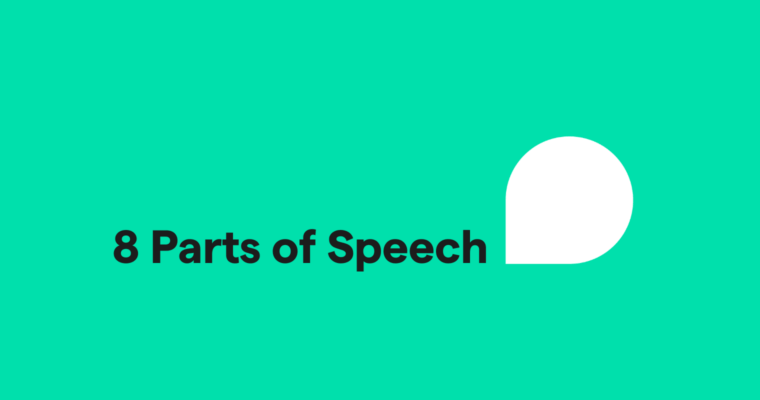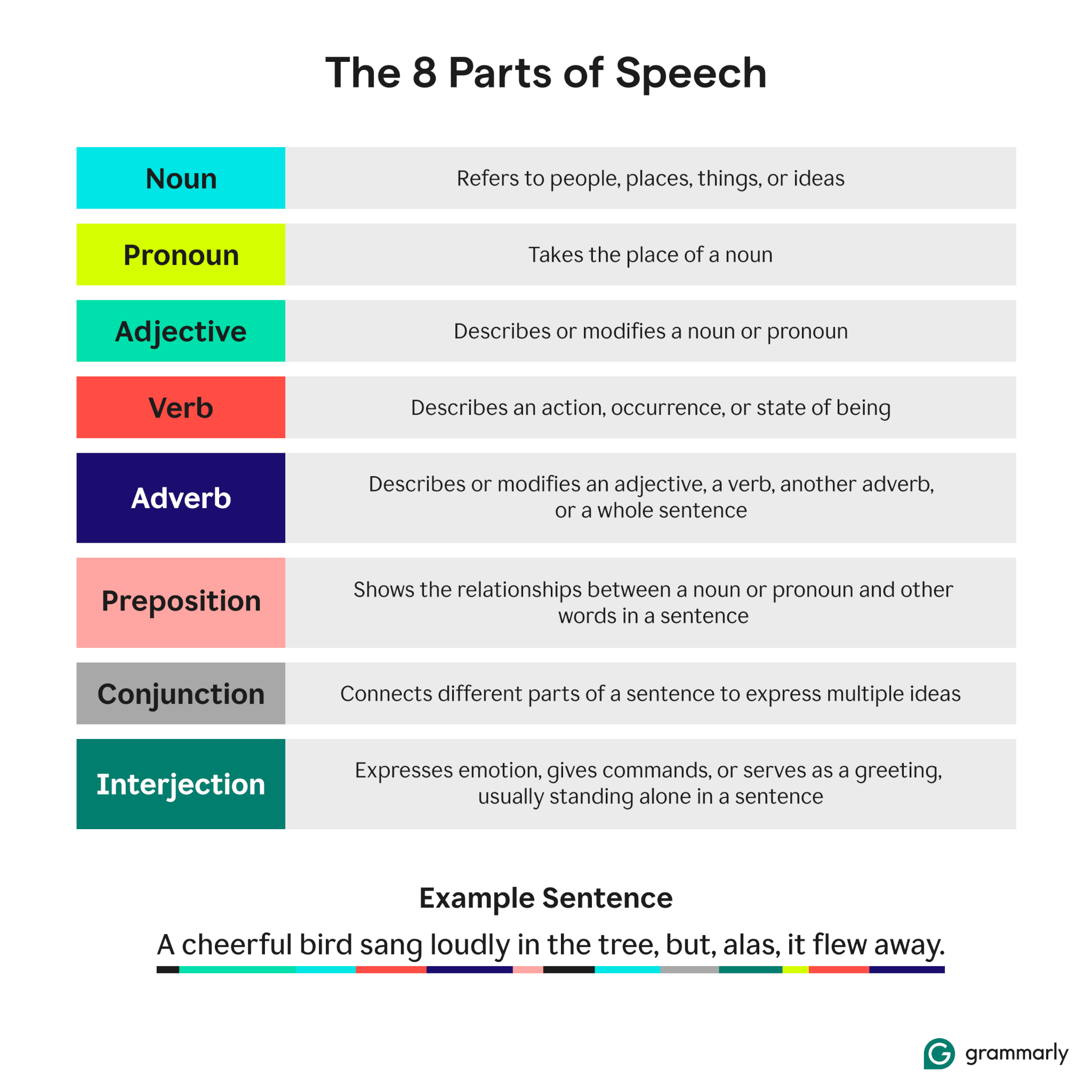
- The eight parts of speech are nouns, pronouns, adjectives, verbs, adverbs, prepositions, conjunctions, and interjections.
- Most words in English can be classified as one of these eight parts of speech, although some, like determiners, are categorized separately in modern grammar.
- The term part of speech refers to a word’s role in a sentence.
- Some words can be different parts of speech depending on how they’re used in a sentence, such as work (noun and verb) and well (adverb, adjective, and noun).
- The parts of speech fall into two word classes: open (parts of speech that regularly acquire new words) and closed (parts of speech that don’t readily acquire new words).
Mastering the parts of speech is essential for clear communication, strong writing, and learning other languages. Here, we’ll explore the rules behind the different parts of speech and how to use them together in grammatically correct sentences, with examples.
Table of contents
What are the 8 English parts of speech?
How to identify parts of speech
When a word can be different parts of speech
What are parts of speech?
Parts of speech are the categories into which words are classified based on their functions in a sentence. They are the fundamental building blocks of grammar, grouping words into categories based on their roles and how they function within a sentence.
These categories help us understand how words relate to each other and contribute to the overall meaning of a sentence.
What are the 8 English parts of speech?
Here are the eight parts of speech:

1 Nouns
A noun is a word that names a person, place, concept, or object. Essentially, anything that names a thing is a noun.
Common vs. proper nouns
Nouns fall into two categories: common nouns and proper nouns. Common nouns are general names for things:
Proper nouns are names or titles for specific things:
Nouns can also be concrete or abstract. Concrete nouns refer to physical objects.
The noun flowers refers to a physical object that can be seen, touched, or smelled.
Abstract nouns refer to intangible qualities like love or courage.
Love represents an emotion or an idea, which lack a physical presence.
2 Pronouns
Pronouns are words you substitute for specific nouns when the reader or listener already knows which specific noun you’re referring to.
Instead of saying Jennifer’s name three times in a row, you substituted she and her, and your sentences remained grammatically correct.
Types of pronouns
Pronouns fall into the following categories:
- Subjective: I, he, she, we
- Objective: me, him, her, us
- Possessive: mine, yours, theirs
- Demonstrative: this, that, these
Matching pronouns to number and gender
It’s important to match the pronoun to the noun in number and gender.
Her matches the singular noun teacher in both number (singular) and gender (female). Their matches the number of students (plural).
In this instance, their is plural and does not align with the singular noun teacher.
They/them/their can also be used as a singular, gender-neutral pronoun. Many people use gender-neutral language like they/them/theirs and zie/hir/hirs because they feel these pronouns express their gender identity more accurately than she or he. The most common gender-neutral pronoun is the singular they. Today, it’s not uncommon to see the singular they as the default neutral pronoun.
3 Adjectives
Adjectives are the words that describe nouns. Think about your favorite movie. How would you describe it to a friend who’s never seen it?
When describing the movie with these words, you’re using adjectives. An adjective can go right before the noun it’s describing:
But it doesn’t have to. Sometimes, adjectives are at the end of a sentence:
Types of adjectives
Adjectives fall into the following categories:
- Descriptive: red, large, cheerful
- Quantitative: many, three, few
- Comparative: taller, more beautiful
- Superlative: tallest, most beautiful
When combined, adjectives follow a specific order:
Opinion → Size → Age → Shape → Color → Origin → Material → Purpose
Example She bought a lovely small old round brown British wooden coffee table.
4 Verbs
Verbs are words that describe specific actions, whether physical or mental.
Action vs. nonaction verbs
Verbs that refer to literal actions are known as action verbs.
The verb runs is an action verb describing what he does.
Not all verbs refer to literal actions, though. Verbs that refer to feelings or states of being, like to love and to be, are known as nonaction verbs.
The verb seems is a nonaction verb, describing a state of being rather than an action.
Transitive vs. intransitive verbs
Verbs can also be transitive or instransitive. A transitive verb is an action verb that requires a direct object to complete its meaning. The object receives the action of the verb. Without the object, the sentence may feel incomplete or unclear.
Here, the verb closed requires the object door. What did she close? The door.
An intransitive verb is an action verb that does not require a direct object to complete its meaning. It expresses a complete thought on its own.
There is no object here, and the action verb sleeps is complete without one.
5 Adverbs
An adverb is a word that describes an adjective, a verb, or another adverb. Look for -ly endings (carefully, happily), though not all adverbs follow this pattern (soon, often).
Quietly describes how you entered (verb) the room.
Always describes how frequently a cheetah is faster (adjective) than a lion.
Here are some other examples of adverbs and what they can describe:
- Time: yesterday, always, soon
- Place: here, outside, everywhere
- Manner: quietly, quickly, gracefully
- Degree: very, extremely, almost
6 Prepositions
Prepositions tell you the relationships between other words in a sentence.
Against is the preposition because it tells us where you left your bike.
Without the preposition in, we don’t know where the pizza is.
Here are some examples of what prepositions are used for:
- Direction: to, into, toward
- Location: in, on, under
- Time: at, before, during
- Cause/Reason: because of, due to
7 Conjunctions
Conjunctions make it possible to build complex sentences that express multiple ideas.
Each of these three sentences expresses a clear idea. There’s nothing wrong with listing your preferences like this, but it’s not the most efficient way to do it. Consider this structure instead:
In this sentence, and and but are the two conjunctions linking your ideas.
The 3 types of conjunctions
Here are the three types of conjunctions, with some examples of each:
- Coordinating: and, but, or, yet (I like pizza and pasta.)
- Subordinating: because, although, if (She stayed home because she was sick.)
- Correlative: either/or, neither/nor (Either you apologize, or I’m leaving.)
8 Interjections
An interjection is a word or phrase that expresses a strong emotion, command, reaction, or sudden feeling. It is often used as an exclamation and is typically followed by a comma or exclamation mark. Interjections can stand alone or be inserted into a sentence.
Interjections add emotion and personality to writing, but you should generally avoid them in formal writing.
How to identify parts of speech
Sometimes, it’s difficult to tell which part of speech a word is. Here are a few easy tips for quickly figuring out what part of speech you’re dealing with:
- If it’s an adjective plus the ending -ly, it’s an adverb. Examples: commonly, quickly.
- If you can swap it out for a noun and the sentence still makes sense, it’s a pronoun. Examples: “He played basketball.” / “Steve played basketball.”
- If it’s something you do and you can modify the sentence to include the word do, it’s a verb. Examples: “I have an umbrella.” / “I do have an umbrella.”
- If you can remove the word and the sentence still makes sense although you lose some detail, the word is most likely an adjective. Examples: “She drives a red van.” / “She drives a van.”
And if you’re ever really stumped, just look the word up. Dictionaries typically list a word’s part of speech in its entry, and if it has multiple forms with different parts of speech, they are all listed with examples.
When a word can be different parts of speech
Just like y is sometimes a vowel and sometimes a consonant, some words are sometimes one part of speech and other times another.
Let’s use the example of the word work.
Now, let’s use the word well as another example.
Finally, let’s use the word but as an example.
Sometimes, words evolve to add forms that are new parts of speech. One recent example is the word adult. Before the 2010s, adult was primarily a noun that referred to a fully grown person. It could also be used as an adjective to refer to specific types of media, like adult contemporary music. At the turn of the 2010s, the word adulting, a brand-new verb, appeared in the internet lexicon. As a verb, adulting refers to the act of doing tasks associated with adulthood, like paying bills and grocery shopping.
Open vs. closed word classes
The parts of speech fall into two word classes: open and closed.
Open word classes are the parts of speech that regularly acquire new words. Language evolves, and that evolution usually takes place in nouns, adjectives, adverbs, and verbs.
Closed word classes are the parts of speech that don’t readily acquire new words. These parts of speech are more set in stone and include pronouns, conjunctions, and prepositions.
The word under is a closed class preposition that indicates a relationship between the cat and the table.
The 8 parts of speech FAQs
What are the 8 parts of speech?
Nouns, pronouns, adjectives, verbs, adverbs, prepositions, conjunctions, and interjections.
How do you tell what part of speech a word is?
Look at its role in the sentence. For example, does it describe an action (verb) or a thing (noun)?
Can a word be more than one part of speech?
Yes, words like well and work can function as different parts of speech depending on context.
What’s the difference between open and closed word classes?
Open class words can evolve, while closed class words remain fixed.
What part of speech is the word like?
Like can be a:
- Verb: I like ice cream.
- Preposition: She runs like the wind.
- Conjunction: Do it like I said.






